Unveiling the Potential of Metaheuristics in Transportation: A Path Towards Efficiency, Optimization, and Intelligent Management
Abstract
1. Introduction
- Algorithms and computation-based decision support: Hybrid algorithms, neural networks, cooperative intelligent transport systems, and swarm intelligence, among others.
- Transport: Applicability in maritime transport, impact on inventory management, economic effects of air transport, public transport, green transport and smart cities, multimodal transport, rail transport, electric vehicles, simultaneous collection and delivery systems, logistics optimization, vehicle routing problems, and urban traffic congestion, among others.
- Business: Pursuit of cost savings and improved viability, the key to business survival through efficiency, company benefits, supplier selection calculations, minimization of customer waiting times, the impact of metaheuristics on customer satisfaction, and business intelligence systems.
- Sustainability: From the perspectives of the economy, transport, and the environment.
- Future: flying taxis, drone delivery, and new transport solutions that promise to revolutionize the industry and improve mobility in cities.
2. Literature Review
3. Methodology
4. Results
4.1. General Analysis
4.1.1. Description
4.1.2. Source Analysis
4.1.3. Author Analysis
4.1.4. Affiliation and Country Analysis
4.1.5. Keyword Analysis
4.2. Lessons Learned
Main Trends in the Applications of Metaheuristics in Transportation
- -
- Optimization and metaheuristic methods: This group encompasses methods and strategies to solve complex optimization problems in logistics and transportation. Among these are metaheuristics, simulated annealing, ant colony optimization, and genetic algorithms, which facilitate near-optimal solutions in high-complexity problems (NP-hard problems). It also includes approaches such as local search and large neighborhood search, which enable efficient exploration of the solution space, optimizing routes, and allocating resources effectively.
- -
- Cost and operational efficiency: This group focuses on reducing costs and improving efficiency in logistics operations. Factors such as total cost and operational cost are fundamental, with the aim of optimizing the relationship between performance and efficiency to achieve more profitable logistics that meet objectives. Terms like impact and value highlight the importance of assessing and maximizing added value in the supply chain and at each stage of transportation.
- -
- Planning and scheduling: This group includes terms such as scheduling problem, timetable, and time window, which are key for organizing workflow, avoiding delays, and meeting real-time demands. Depot and collection represent specific aspects in scheduling loading and unloading points, while decision and planning form the foundation of an information system based on rapid response.
- -
- Logistics and transportation: This group includes the fundamental elements of transportation logistics, such as transportation requests and fleet, bus, and vehicle routing problems, which form the basis of route and fleet management. It encompasses specific issues like DARP (dial-a-ride problem), which is common in passenger transport, and capacitated vehicle routing, where vehicle capacity constraints must be considered. It also includes aspects such as urban areas and delivery problems, representing the challenges of transportation in densely populated areas.
- -
- Supply chain and logistics networks: The supply chain manages the flow of goods from origin until the product reaches the end consumer. This group includes terms such as supply chain, network, trade, and location, which are fundamental to logistics network planning. Routing and container are essential for optimization at each stage of transportation and storage, while decision and way enable a comprehensive supply strategy. Risk management and efficiency in the supply chain are crucial to maintaining competitiveness and ensuring the continuous flow of products.
- -
- Energy and sustainability: In the context of growing environmental concerns, energy and sustainability are key factors in transportation optimization. These aspects are of interest beyond economic sectors, such as for governments of countries striving for carbon neutrality. This group includes terms like energy and electric vehicles, which represent the shift towards more eco-friendly transportation options, especially in urban areas.
- -
- Demand and users: This group focuses on demand and how to meet the expectations and needs of users. Customer demand and demand reflect the pressure the market places on logistics operations, driving the adaptation of services and resources to improve customer satisfaction. Understanding these demands enables the design of routes and schedules that are more aligned with the final customer’s needs, thereby enhancing service experience and efficiency.
- -
- Allocation problem: In the ‘location problem’ in logistics, key terms appear that influence its solution. Finding optimal ‘locations’ for resource allocation within a ‘network’ of transportation is essential for efficient operations. Elements like ‘terminals’, ‘containers’, and ‘vessels’ are optimized to maximize ‘efficiency’ and ‘performance’ while minimizing ‘costs’. As an ‘NP-hard problem’, techniques such as ‘local search’ and ‘genetic algorithms’ are applied to explore solutions in ‘routes’ and ‘capacities’. Additionally, ‘scheduling’ and destination selection are crucial for ensuring the system operates both efficiently and profitably.
- -
- Combinatorial optimization: In the ‘combinatorial optimization’ problem, key terms appear that impact its resolution. ‘Efficiency’ plays a critical role in achieving optimal resource use, while reducing ‘cost’ directly affects profitability in complex systems. Techniques such as ‘bee colony optimization’ and ‘genetic algorithm’ are applied to manage the ‘complexity’ of options within a ‘network’, enhancing decision-making processes in logistics and resource allocation.
- -
- The dial-a-ride problem (DARP): In the ‘Dial-a-Ride Problem’ (‘DARP’), key terms appear that influence its resolution. ‘Transportation requests’ reflect the demand for transportation services from ‘users’ or ‘passengers’, directly impacting route planning and vehicle allocation across different ‘locations’. The ‘time window’ sets pickup and drop-off schedules, limiting flexibility and requiring precision in operations. The ‘cost’ associated with routes affects the budget and profitability of the service, while techniques like ‘variable neighborhood search’ help optimize ‘efficiency’ in ‘fleet’ management, ensuring effective service within time and distance constraints.
- -
- Ant colony solutions: In ‘ant colony optimization’, key terms appear that influence its application and effectiveness. Following the ‘genetic algorithm’, it is the most commonly co-occurring technique for tackling complex problems. As an ‘NP-hard problem’ solver, ‘ant colony optimization’ is widely applied to challenges like the ‘vehicle routing problem’ and ‘salesman problem’, where ‘routing’ and ‘optimization’ are crucial. This technique enhances ‘performance’ and ‘efficiency’ by simulating natural ant behavior to find optimal paths within a ‘network’. Its frequent use alongside the ‘genetic algorithm’ further strengthens decision-making in logistics.
- -
- Variable neighborhood search: In ‘variable neighborhood search’, key terms emerge that shape its application in logistics and transportation optimization. It is frequently used for solving the ‘vehicle routing problem’ and ‘scheduling problem’, where flexibility in exploring different solutions enhances outcomes. Techniques like ‘tabu search’ are often combined to improve ‘delivery’ and ‘routing’ efficiency. Factors such as ‘time window’, ‘location’, and ‘capacity’ play critical roles in meeting demands within a ‘network’ while balancing ‘cost’ and maximizing ‘performance’. Applications in the ‘ride problem’ allow for optimized planning, benefiting ‘passenger’ services and resource allocation.
- -
- Transportation scheduling problems (TSP): In the ‘Traveling Salesman Problem’ (‘TSP’), key terms appear that significantly impact its resolution. In the ‘first stage’, ‘initial solutions’ are developed as a foundation for advanced techniques like ‘hybrid metaheuristics’, which combine methods such as ‘tabu search’ and ‘variable neighborhood search’ to refine solutions. Factors like ‘distance’, ‘time window’, and ‘timetable’ are crucial for coordinating ‘routing’ and ‘delivery’, optimizing the use of ‘truck’ and ‘bus’ to fulfill the demand of ‘passengers’ and cargo. Efficient ‘operator’ management and resource allocation are essential to balance ‘cost’ and ‘performance’, enhancing operational ‘ability’ in a complex logistics environment. ‘Genetic algorithms’ are among the most widely used techniques for solving this problem.
- -
- Genetic algorithms: The ‘genetic algorithm’ is one of the most widely used methods in combinatorial optimization for solving complex ‘NP-hard problems’. This approach enables the identification of ‘feasible solutions’ by selecting and evolving optimal combinations within a ‘network’. Its ability to integrate with techniques such as ‘simulated annealing’, ‘tabu search’, and ‘ant colony optimization’ allows for a ‘hybrid metaheuristic’ approach that enhances performance.
5. Discussion
5.1. Innovation Factor
- -
- As the only bibliometric study focusing on metaheuristics in the transport sector, this research presents several significant implications and benefits:
- -
- Innovation and advancement of knowledge. As a pioneer in its field, this study provides a comprehensive analysis and unique insight into how metaheuristics are being applied to transportation. This can boost future research and open up new avenues of study.
- -
- Identification of trends and gaps in research. By providing an overview of the current state of research in this area, the study can help identify prevailing trends as well as research niches that could advance research in this field.
- -
- Facilitate evidence-based decision-making. This study can provide decision-makers with valuable insights into which metaheuristic techniques and strategies have proven most effective in transportation, helping them make more informed and effective decisions.
- -
- Contribution to transport optimization. By highlighting how metaheuristics are being applied in transport, this study can contribute to improving and optimizing transport systems, which in turn can lead to benefits in terms of efficiency, sustainability, and cost reduction.
- -
- Orientation towards finance and economics. Optimization leads to savings in terms of time, resources, or raw materials. This is reflected in the economic aspect of businesses, making this perspective essential to unify both variables in a paper, bringing together two necessary disciplines for the prosperity of economic sectors.
5.2. General Discussion
6. Conclusions and Research Implications
Author Contributions
Funding
Data Availability Statement
Conflicts of Interest
References
- Osman, I.H.; Laporte, G. Metaheuristics: A bibliography. Ann. Oper. Res. 1996, 63, 511–623. [Google Scholar] [CrossRef]
- Gogna, A.; Tayal, A. Metaheuristics: Review and application. J. Exp. Theor. Artif. Intell. 2013, 25, 503–526. [Google Scholar] [CrossRef]
- Elaziz, M.A.; Elsheikh, A.H.; Oliva, D.; Abualigah, L.; Lu, S.; Ewees, A.A. Advanced Metaheuristic Techniques for Mechanical Design Problems: Review. Arch. Comput. Methods Eng. 2021, 29, 695–716. [Google Scholar] [CrossRef]
- Juan, A.A.; Keenan, P.; Martí, R.; McGarraghy, S.; Panadero, J.; Carroll, P.; Oliva, D. A review of the role of heuristics in stochastic optimisation: From metaheuristics to learn heuristics. Ann. Oper. Res. 2021, 320, 831–861. [Google Scholar] [CrossRef]
- Safi, S.A.-D.; Castillo, P.A.; Faris, H. Cost-Sensitive Metaheuristic Optimization-Based Neural Network with Ensemble Learning for Financial Distress Prediction. Appl. Sci. 2022, 12, 6918. [Google Scholar] [CrossRef]
- Bousbaa, Z.; Bencharef, O. Metaheuristics for Financial Investment Strategies: Applications Survey. In Proceedings of the 2023 3rd International Conference on Electrical, Computer, Communications and Mechatronics Engineering (ICECCME) Tenerife, Canary Islands, Spain, 19–21 July 2023; pp. 1–6. [Google Scholar]
- Saber, M.; Abdelhamid, A.A.; Ibrahim, A. Metaheuristic Optimization Review: Algorithms and Applications. J. Artif. Intell. Metaheuristics 2023, 3, 21–30. [Google Scholar] [CrossRef]
- Lai, M.; Battarra, M.; Di Francesco, M.; Zuddas, P. An adaptive guidance meta-heuristic for the vehicle routing problem with splits and clustered backhauls. J. Oper. Res. Soc. 2015, 66, 1222–1235. [Google Scholar] [CrossRef]
- Eskandarpour, M.; Ouelhadj, D.; Fletcher, G. Decision making using metaheuristic optimization methods in sustainable transportation. Sustain. Transp. Smart Logist. 2019, 11, 285–304. [Google Scholar]
- Ferreira, J.C.; Arns, M.T. A complexity task of optimization in logistic distribution: A new approach to the green multi-objective vehicle routing problem. Int. J. Numer. Methods Calc. Des. Eng. 2022, 38, 1–11. [Google Scholar]
- Parvasi, S.P.; Mahmoodjanloo, M.; Setak, M. A bi-level school bus routing problem with bus stops selection and possibility of demand outsourcing. Appl. Soft Comput. 2017, 61, 222–238. [Google Scholar] [CrossRef]
- Iliopoulou, C.; Tassopoulos, I.; Beligiannis, G. A Variable Neighbourhood Search-Based Algorithm for the Transit Route Network Design Problem. Appl. Sci. 2022, 12, 10232. [Google Scholar] [CrossRef]
- Corrêa, V.; Santos, A.; Nogueira, T. Strategies for Electric Location-routing Problems Considering Short and Long Term Horizons. In Proceedings of the 23rd International Conference on Enterprise Information Systems, Online, 26–28 April 2021; pp. 795–802. [Google Scholar]
- Erdelić, T.; Carić, T. Goods Delivery with Electric Vehicles: Electric Vehicle Routing Optimization with Time Windows and Partial or Full Recharge. Energies 2022, 15, 285. [Google Scholar] [CrossRef]
- Reyes-Rubiano, L.S.; Ferone, D.; Juan, A.A.; Faulin, J. A simheuristic for routing electric vehicles with limited driving ranges and stochastic travel times. Sort-Stat. Oper. Res. Trans. 2019, 43, 3–24. [Google Scholar]
- Iqbal, Z.; Azhar, E.; Mehmood, Z.; Sabir, M.M. Neural based hybrid metaheuristic technique for computing rotating transport of Falkner-Skan flow. Alex. Eng. J. 2018, 57, 2123–2132. [Google Scholar] [CrossRef]
- John, K.; Paul, B.; Rajendran, C.; Ziegler, H. Priority fractional rationing (PFR) policy and a hybrid metaheuristic for managing stock in divergent supply chains. Sadhana 2022, 47, 254. [Google Scholar] [CrossRef]
- Milán-García, J.; Rueda-López, N.; De Pablo-Valenciano, J. Local government efficiency: Reviewing determinants and setting new trends. Int. Trans. Oper. Res. 2021, 29, 2871–2898. [Google Scholar] [CrossRef]
- Hudzaifah, H.; Rizana, A.F.; Ramadhan, F.; Imran, A. Intelligent decision support systems for deter-mining tour bus route with time windows: A metaheuristic approach. IOP Conf. Ser. Mater. Sci. Eng. 2020, 830, 032085. [Google Scholar] [CrossRef]
- Hasani, A.; Khosrojerdi, A. Robust global supply chain network design under disruption and uncertainty considering resilience strategies: A parallel memetic algorithm for a real-life case study. Transp. Res. Part E Logist. Transp. Rev. 2016, 87, 20–52. [Google Scholar] [CrossRef]
- Tak, S.; Kim, J.; Lee, D. Study on the extraction method of sub-network for optimal operation of connected and automated vehicle-based mobility service and its implication. Sustainability 2022, 14, 3688. [Google Scholar] [CrossRef]
- Somakumar, R.; Kasinathan, P.; Monicka, G.; Rajagopalan, A.; Ramachandaramurthy, V.K.; Subramaniam, U. Optimization of emission cost and economic analysis for microgrid by considering a metaheuristic algorithm-assisted dispatch model. Int. J. Numer. Model Electron. Netw. Devices Fields 2022, 35, e2993. [Google Scholar] [CrossRef]
- Korkou, T.; Souravlias, D.; Parsopoulos, K.E.; Skouri, K. Metaheuristic optimization for logistics in natural disasters. Int. Conf. Dyn. Disasters 2016, 185, 113–134. [Google Scholar]
- Ntakolia, C.; Lyridis, D.V. A swarm intelligence graph-based pathfinding algorithm based on fuzzy log-ic (SIGPAF): A case study on unmanned surface vehicle Multi-Objective path planning. J. Mar. Sci. Eng. 2021, 9, 1243. [Google Scholar] [CrossRef]
- Tangpattanakul, P.; Quenel, I. Optimal scheduling for flying taxi operation. In Proceedings of the 13th Inter-national Joint Conference on Computational Intelligence (IJCCI 2021), Valletta, Malta, 25–27 October 2021. [Google Scholar]
- Bouzid, M.; Alaya, I.; Tagina, M. A Bee Colony Optimization Algorithm for the Long-Term Car Pooling Problem. In Proceedings of the 15th International Conference on Software Technologies, Paris, France, 7–9 July 2020; pp. 319–327. [Google Scholar]
- Glover, F. Tabu Search—Part I. ORSA J. Comput. 1989, 1, 190–206. [Google Scholar] [CrossRef]
- Schweickardt, G.; Miranda, V. FEPSO metaheuristic applied to combinatorial optimization problems: Phase balancing in electrical distribution systems. Cienc. Docencia Y. Tecnol. 2010, 21, 133–163. [Google Scholar]
- Mousazadeh, M.; Torabi, S.A.; Zahiri, B. A robust possibilistic programming approach for pharmaceutical supply chain network design. Comput. Chem. Eng. 2015, 82, 115–128. [Google Scholar] [CrossRef]
- Aydinalp, Z.; Özgen, D. Solving vehicle routing problem with time windows using metaheuristic approaches. Int. J. Intell. Comput. Cybern. 2022, 16, 121–138. [Google Scholar] [CrossRef]
- Akpinar, M.E. A logistic optimization for the vehicle routing problem through a case study in the food industry. Logforum 2015, 17, 387–397. [Google Scholar] [CrossRef]
- Dong, X.; Li, D.; Yin, Y.; Ding, S.; Cao, Z. Integrated optimization of train stop planning and timetabling for commuter railways with an extended adaptive large neighborhood search metaheuristic approach. Transp. Res. Part C Emerg. Technol. 2020, 117. [Google Scholar] [CrossRef]
- Arreeras, S.; Arimura, M. A study on shelter airport selection during large-scale volcanic disasters using CARATS open dataset. Transp. Res. Part C Emerg. Technol. 2021, 129, 103263. [Google Scholar] [CrossRef]
- Jana, R.K.; Sharma, D.K.; Mehta, P. A probabilistic fuzzy goal programming model for managing the supply of emergency relief materials. Ann. Oper. Res. 2021, 319, 149–172. [Google Scholar] [CrossRef] [PubMed]
- Gulić, M.; Maglić, L.; Krljan, T.; Maglić, L. Solving the container relocation problem by using a metaheuristic genetic algorithm. Appl. Sci. 2022, 12, 7397. [Google Scholar] [CrossRef]
- Zetina, C.A.; Contreras, I.; Cordeau, J.F. Profit-oriented fixed-charge network design with elastic demand. Transp. Res. Part B Methodol. 2019, 127, 1–19. [Google Scholar] [CrossRef]
- Chaieb, M.; Ben Sassi, D. Measuring and evaluating the home health care scheduling problem with simultaneous pick-up and delivery with time window using a tabu search metaheuristic solution. Appl. Soft Comput. 2021, 113, 107957. [Google Scholar] [CrossRef]
- Wang, W.; Jiang, Y.; Peng, Y.; Zhou, Y.; Tian, Q. A simheuristic method for the reversible lanes allocation and scheduling problem at Smart Container Terminal Gate. J. Adv. Transp. 2018, 1–14. [Google Scholar] [CrossRef]
- Aydın, M.M. The modeling of effective parameters on public bus passengers’ boarding time prediction. J. Eng. Res. 2021, 10, 1–16. [Google Scholar] [CrossRef]
- Özdemir, D.; Dörterler, S. An adaptive search equation-based artificial bee colony algorithm for transportation energy demand forecasting. Turk. J. Electr. Eng. Comput. Sci. 2022, 30, 1251–1268. [Google Scholar] [CrossRef]
- Ning, S.; Yuan, Z.; Han, Z.; Yang, Y. An Advanced and Adaptive Tabu Search Algorithm for Dynamic Shared Parking Reservation and Allocation. Stud. Inform. Control 2022, 31, 97–106. [Google Scholar] [CrossRef]
- Öztaş, T.; Tuş, A. A hybrid metaheuristic algorithm based on iterated local search for vehicle routing problem with simultaneous pickup and delivery. Expert Syst. Appl. 2022, 202, 117401. [Google Scholar] [CrossRef]
- Ntakolia, C.; Lyridis, D.V. Ant colony optimization with fuzzy logic for air traffic flow management. Oper. Res. 2022, 22, 5035–5053. [Google Scholar] [CrossRef]
- Baspinar, B.; Ure, N.K.; Koyuncu, E.; Inalhan, G. Analysis of Delay Characteristics of European Air Traffic through a Data-Driven Airport-Centric Queuing Network Model. IFAC-PapersOnLine 2016, 49, 359–364. [Google Scholar] [CrossRef]
- Oner, N.; Gultekin, H.; Koç, A. The airport shuttle bus scheduling problem. Int. J. Prod. Res. 2020, 59, 7400–7422. [Google Scholar] [CrossRef]
- Mahdavi, S.M.H.; Rao, K.R.; Tiwari, G.; Biyani, P. Simultaneous bus transit route network and frequency setting search algorithm. J. Transp. Eng. Part A Syst. 2019, 145, 04019011. [Google Scholar] [CrossRef]
- Saleu, R.G.M.; Deroussi, L.; Feillet, D.; Grangeon, N.; Quilliot, A. The parallel drone scheduling problem with multiple drones and vehicles. Eur. J. Oper. Res. 2022, 300, 571–589. [Google Scholar] [CrossRef]
- Posada, M.; Häll, C.H. A metaheuristic for evaluation of an integrated special transport service. Int. J. Urban Sci. 2020, 24, 316–338. [Google Scholar] [CrossRef]
- El Raoui, H.; Oudani, M.; Pelta, D.A.; Alaoui, A.E.H. A Metaheuristic Based Approach for the Customer-Centric Perishable Food Distribution Problem. Electronics 2021, 10, 2018. [Google Scholar] [CrossRef]
- Baals, J.; Emde, S.; Turkensteen, M. Minimizing earliness-tardiness costs in supplier networks—A just-in-time truck routing problem. Eur. J. Oper. Res. 2022, 306, 707–741. [Google Scholar] [CrossRef]
- Movassaghi, M.; Darestani, S.A. Multiple Cross-docks Scheduling with Multiple Doors using Fuzzy Approach and Metaheuristic Algorithms. J. Oper. Res. Soc. China 2022, 10, 861–911. [Google Scholar] [CrossRef]
- Dulebenets, M.A. A Delayed Start Parallel Evolutionary Algorithm for just-in-time truck scheduling at a cross-docking facility. Int. J. Prod. Econ. 2019, 212, 236–258. [Google Scholar] [CrossRef]
- Repolho, H.M.; Marchesi, J.F.; Júnior, O.S.S.; Bezerra, R.R.R. Cargo theft weighted vehicle routing problem: Modeling and application to the pharmaceutical distribution sector. Soft Comput. 2018, 23, 5865–5882. [Google Scholar] [CrossRef]
- Rabbani, M.; Heidari, R.; Farrokhi-Asl, H.; Rahimi, N. Using metaheuristic algorithms to solve a multi-objective industrial hazardous waste location-routing problem considering incompatible waste types. J. Clean. Prod. 2018, 170, 227–241. [Google Scholar] [CrossRef]
- Gholian-Jouybari, F.; Afshari, A.J.; Paydar, M.M. Utilizing new approaches to address the fuzzy fixed charge transportation problem. J. Ind. Prod. Eng. 2018, 35, 148–159. [Google Scholar] [CrossRef]
- Eydi, A.; Fazli, L. A Multi-Period Multiple Objective Uncertain Programming Model to Allocate Order for Supplier Selection Problem. Asia-Pac. J. Oper. Res. 2016, 33, 1650045. [Google Scholar] [CrossRef]
- Dožić, S.; Jelović, A.; Kalić, M.; Čangalović, M. Variable Neighborhood Search to solve an airline fleet sizing and fleet assignment problem. Transp. Res. Procedia 2019, 37, 258–265. [Google Scholar] [CrossRef]
- Chen, L.; Chiang, W.C.; Russell, R.; Chen, J.; Sun, D. The probabilistic vehicle routing problem with service guarantees. Transp. Res. Part E Logist. Transp. Rev. 2018, 111, 149–164. [Google Scholar] [CrossRef]
- Li, D.; Antoniou, C.; Jiang, H.; Xie, Q.; Shen, W.; Han, W. The Value of Prepositioning in Smartphone-Based Vanpool Services under Stochastic Requests and Time-Dependent Travel Times. Transp. Res. Rec. J. Transp. Res. Board 2019, 2673, 26–37. [Google Scholar] [CrossRef]
- Sarkar, B.; Tayyab, M.; Kim, N.; Habib, M.S. Optimal production delivery policies for supplier and manufacturer in a constrained closed-loop supply chain for returnable transport packaging through metaheuristic approach. Comput. Ind. Eng. 2019, 135, 987–1003. [Google Scholar] [CrossRef]
- Masmoudi, M.A.; Hosny, M.; Demir, E.; Genikomsakis, K.N.; Cheikhrouhou, N. The dial-a-ride problem with electric vehicles and battery swapping stations. Transp. Res. Part E Logist. Transp. Rev. 2018, 118, 392–420. [Google Scholar] [CrossRef]
- Patel, M.; Valderrama, C.; Yadav, A. Metaheuristic enabled deep convolutional neural network for traffic flow prediction: Impact of improved lion algorithm. J. Intell. Transp. Syst. 2021, 26, 730–745. [Google Scholar] [CrossRef]
- Yanik, S.; Bozkaya, B.; Dekervenoael, R. A new VRPPD model and a hybrid heuristic solution approach for e-tailing. Eur. J. Oper. Res. 2014, 236, 879–890. [Google Scholar] [CrossRef]
- Ghaffarinasab, N.; Van Woensel, T.; Minner, S. A continuous approximation approach to the planar hub location-routing problem: Modeling and solution algorithms. Comput. Oper. Res. 2018, 100, 140–154. [Google Scholar] [CrossRef]
- Laporte, G. What you should know about the vehicle routing problem. Nav. Res. Logist. 2007, 54, 811–819. [Google Scholar] [CrossRef]
- Shamsaldin, A.S.; Rashid, T.A.; Agha, R.A.A.-R.; Al-Salihi, N.K.; Mohammadi, M. Donkey and smuggler optimization algorithm: A collaborative working approach to path finding. J. Comput. Des. Eng. 2019, 6, 562–583. [Google Scholar] [CrossRef]
- Shabbar, R.; Kasasbeh, A.; Ahmed, M.M. Charging Station Allocation for Electric Vehicle Network Using Stochastic Modeling and Grey Wolf Optimization. Sustainability 2021, 13, 3314. [Google Scholar] [CrossRef]
- Hammedi, W.; Senouci, S.M.; Brunet, P.; Ramirez-Martinez, M. Two-Level Optimization to Reduce Waiting Time at Locks in Inland Waterway Transportation. ACM Trans. Intell. Syst. Technol. 2022, 13, 1–30. [Google Scholar] [CrossRef]
- Canca, D.; De-Los-Santos, A.; Laporte, G.; Mesa, J.A. Integrated Railway Rapid Transit Network Design and Line Planning problem with maximum profit. Transp. Res. Part E: Logist. Transp. Rev. 2019, 127, 1–30. [Google Scholar] [CrossRef]
- Hu, Q.; Zhang, Z.; Baldacci, R.; Tarantilis, C.D.; Zachariadis, E. The bus sightseeing problem. Int. Trans. Oper. Res. 2022, 30, 4026–4060. [Google Scholar] [CrossRef]
- Lazarides, M.K.; Lazaridou, I.; Papanas, N. Bibliometric analysis: Bridging informatics with science. Int. J. Low. Extrem. Wounds. 2023. [Google Scholar] [CrossRef] [PubMed]
- Ellegaard, O. The application of bibliometric analysis: Disciplinary and user aspects. Scientometrics 2018, 116, 181–202. [Google Scholar] [CrossRef]
- Dávila, M.; Guzmán, R.; Macareno, H.; Piñeres, D.; De La Rosa, D.; Caballero-Uribe, C.V. Bibliometrics: Concepts and applications for medical studies and professional training. Rev. Salud Uninorte 2009, 25, 319–330. [Google Scholar]
- Povedano-Montero, F.J.; Álvarez-Peregrina, C.; Cruz, F.D.H.S.; Villa-Collar, C.; Valverde, J.M.S. Bibliometric Study of Scientific Research on Scleral Lenses. Eye Contact Lens Sci. Clin. Pr. 2018, 44, S285–S291. [Google Scholar] [CrossRef]
- Müller, H.; Mancuso, F. Identification and Analysis of Co-Occurrence Networks with NetCutter. PLoS ONE 2008, 3, e3178. [Google Scholar] [CrossRef]
- Ropke, S.; Pisinger, D. An adaptive large neighborhood search heuristic for the pickup and delivery problem with time windows. Transp. Sci. 2006, 40, 455–472. [Google Scholar] [CrossRef]
- Bräysy, O.; Gendreau, M. Vehicle routing problem with Time Windows, Part I: Route construction and local search algorithms. Transp. Sci. 2005, 39, 104–118. [Google Scholar] [CrossRef]
- Laporte, G. Fifty years of vehicle routing. Transp. Sci. 2009, 43, 408–416. [Google Scholar] [CrossRef]
- Schneider, M.; Stenger, A.; Goeke, D. The electric vehicle-routing problem with time windows and recharging stations. Transp. Sci. 2014, 48, 500–520. [Google Scholar] [CrossRef]
- Bräysy, O.; Gendreau, M. Vehicle routing problem with time windows, Part II: Metaheuristics. Transp. Sci. 2005, 39, 119–139. [Google Scholar] [CrossRef]
- Coelho, L.C.; Cordeau, J.; Laporte, G. Thirty years of inventory routing. Transp. Sci. 2013, 48, 1–19. [Google Scholar] [CrossRef]
- Pisinger, D.; Ropke, S. Large neighborhood search. In International Series in Operations Research & Management Science; Springer: Berlin/Heidelberg, Germany, 2010; pp. 399–419. [Google Scholar] [CrossRef]
- Peng, P.; Snyder, L.V.; Lim, A.; Liu, Z. Reliable logistics networks design with facility disruptions. Transp. Res. Part B Methodol. 2011, 45, 1190–1211. [Google Scholar] [CrossRef]
- Keskin, M.; Çatay, B. Partial recharge strategies for the electric vehicle routing problem with time windows. Transp. Res. Part C Emerg. Technol. 2016, 65, 111–127. [Google Scholar] [CrossRef]
- Montoya, A.; Guéret, C.; Mendoza, J.E.; Villegas, J.G. The electric vehicle routing problem with nonlinear charging function. Transp. Res. Part B Methodol. 2017, 103, 87–110. [Google Scholar] [CrossRef]
- Khalifehzadeh, S.; Fakhrzad, M.; Mehrjerdi, Y.Z.; Hosseini_Nasab, H. Two effective metaheuristic algorithms for solving a stochastic optimization model of a multi-echelon supply chain. Appl. Soft Comput. 2018, 76, 545–563. [Google Scholar] [CrossRef]
- Guersola, M.; Arns Steiner, M.T.; Scarpin, C.T. A methodology for minimizing LPG transportation impact. Manag. Environ. Qual. Int. J. 2017, 28, 807–820. [Google Scholar] [CrossRef]
- Bouzid, M.; Alaya, I.; Tagina, M. Guided bee colony algorithm applied to the daily car-pooling problem. In Proceedings of the 16th International Conference on Software Technologies, Online, 6–8 July 2021. [Google Scholar]
- Ozarik, S.S.; Veelenturf, L.P.; Woensel, T.V.; Laporte, G. Optimizing e-commerce last-mile vehicle routing and scheduling under uncertain customer presence. Transp. Res. Part E Logist. Transp. Rev. 2021, 148, 102263. [Google Scholar] [CrossRef]
- Ferreira, J.C.; Steiner, M.T.A.; Guersola, M.S. A Vehicle Routing Problem Solved Through Some Metaheuristics Procedures: A Case Study. IEEE Lat. Am. Trans. 2017, 15, 943–949. [Google Scholar] [CrossRef]
- Singh, D. A modified bio inspired: BAT algorithm. Int. J. Appl. Metaheuristic Comput. 2018, 9, 60–77. [Google Scholar] [CrossRef]
- Zhao, X.; Lin, Q.; Yu, H. A Co-Scheduling Problem of Ship Lift and Ship Lock at the Three Gorges Dam. IEEE Access 2020, 8, 132893–132910. [Google Scholar] [CrossRef]
- Vieira, Y.E.M.; Bandeira, R.A.d.M.; Júnior, O.S.d.S. Multi-depot vehicle routing problem for large scale disaster relief in drought scenarios: The case of the Brazilian northeast region. Int. J. Disaster Risk Reduct. 2021, 58, 102193. [Google Scholar] [CrossRef]
- Fattahi, Z.; Behnamian, J. Location and transportation of intermodal hazmat considering equipment capacity and congestion impact: Elastic method and sub-population genetic algorithm. Ann. Oper. Res. 2021, 316, 303–341. [Google Scholar] [CrossRef]
- Spence, D.P.; Owens, K.C. Lexical co-occurrence and association strength. J. Psycholinguist. Res. 1990, 19, 317–330. [Google Scholar] [CrossRef]
- Jenkins, J.J.; Mink, W.D.; Russell, W.A. Associative Clustering as a Function of Verbal Association Strength. Psychol. Rep. 1958, 4, 127–136. [Google Scholar] [CrossRef]
- Mirboland, M.; Smarsly, K. BIM-Based Description of Intelligent Transportation Systems for Roads. Infrastructures 2021, 6, 51. [Google Scholar] [CrossRef]
- Ezugwu, A.E.; Shukla, A.K.; Agbaje, M.B.; Oyelade, O.N.; José-García, A.; Agushaka, J.O. Automatic clustering algorithms: A systematic review and bibliometric analysis of relevant literature. Neural Comput. Appl. 2020, 33, 6247–6306. [Google Scholar] [CrossRef]
- Ezugwu, A.E.; Shukla, A.K.; Nath, R.; Akinyelu, A.A.; Agushaka, J.O.; Chiroma, H.; Muhuri, P.K. Metaheuristics: A comprehensive overview and classification along with bibliometric analysis. Artif. Intell. Rev. 2021, 54, 4237–4316. [Google Scholar] [CrossRef]
- Baghalzadeh, M.; Keivani, A.; Moehler, R.C.; Jelodari, N.; Laleh, S.R. Internet of Things (IoT), Building Information Modeling (BIM), and Digital Twin (DT) in construction industry: A review, bibliometric, and network analysis. Buildings 2022, 12, 1503. [Google Scholar] [CrossRef]
- Ajibade, S.M.; Ojeniyi, A. Bibliometric survey on particle swarm optimization algorithms (2001–2021). J. Electr. Comput. Eng. 2022, 2022, 1–12. [Google Scholar] [CrossRef]
- Rabbouch, B.; Rabbouch, H.; Saâdaoui, F. Parallel processing algorithms for the vehicle routing problem and its variants: A literature review with a look into the future. Lect. Notes Comput. Sci. 2020, 591–605. [Google Scholar] [CrossRef]
- Deniz, N.; Ozceylan, E. A bibliometric and social network analysis of data-driven heuristic methods for logistics problems. J. Ind. Manag. Optim. 2023, 19. [Google Scholar] [CrossRef]
- Kiani, R.; Goh, M.; Mavi, N.K.; Jie, F.; Brown, K.; Biermann, S.; Khanfar, A.A. Cross-docking: A systematic literature review. Sustainability 2020, 12, 4789. [Google Scholar] [CrossRef]
- Stegherr, H.; Heider, M.; Hähner, J. Classifying Metaheuristics: Towards a unified multi-level classification system. Nat. Comput. 2020, 21, 155–171. [Google Scholar] [CrossRef]
- Baketarić, M.; Mernik, M.; Kosar, T. Attraction Basins in Metaheuristics: A Systematic Mapping Study. Mathematics 2021, 9, 3036. [Google Scholar] [CrossRef]
- Amin, A.; Altinoz, B.; Dogan, E. Analyzing the determinants of carbon emissions from transportation in European countries: The role of renewable energy and urbanization. Clean Technol. Environ. Policy 2020, 22, 1725–1734. [Google Scholar] [CrossRef]
- Wang, C.; Zhao, Y.; Wang, Y.; Wood, J.; Kim, C.Y.; Li, Y. Transportation CO2 emission decoupling: An assessment of the Eurasian logistics corridor. Transp. Res. Part D Transp. Environ. 2020, 86, 102486. [Google Scholar] [CrossRef]
- Bhatnagar, A.; Shukla, A.K. Ann based optimization techniques for transportation problems: A review. Int. J. Mod. Trends Eng. Res. 2017, 4, 56–60. [Google Scholar]
- Singh, P.; Elmi, Z.; Lau, Y.-Y.; Borowska-Stefańska, M.; Wiśniewski, S.; Dulebenets, M.A. Blockchain and AI technology convergence: Applications in transportation systems. Veh. Commun. 2022, 38. [Google Scholar] [CrossRef]
- Tian, G.; Li, Z.; Yu, D.; Fathollahi-Fard, A.M.; Jin, L.; Jiang, X. Editorial Conclusion for the Special Issue “Advanced Transportation Technologies and Symmetries in Intelligent Transportation Systems”. Symmetry 2022, 14, 1439. [Google Scholar] [CrossRef]
- Sarasola, B.; Doerner, K.F. Adaptive large neighborhood search for the vehicle routing problem with synchronization constraints at the delivery location. Networks 2019, 75, 64–85. [Google Scholar] [CrossRef]
- Gila, A. High Performance Computing Applied to Competitive Facility Location and Design Problems: Single and Multi-Objective Optimization Algorithms [Tesis Doctoral, University of Almeria] 2013. Available online: https://produccioncientifica.ucm.es/documentos/5da5a68829995264b791a53f (accessed on 10 December 2024).
- Alkarawy, H.G.W.; Al-Kuwair, E.J.M. Accounting improving the costs and business process management in transportation to a third party. Accounting 2021, 7, 701–708. [Google Scholar] [CrossRef]
- Kerot, T.; Deesamer, K.; Sanonok, A.; Baobuangoen, J.; Pornsing, C. A critical study of transportation cost in inland road transportation business. Naresuan Univ. J. Sci. Technol. 2021, 29, 43–51. [Google Scholar]
- Ochelska-Mierzejewska, J.; Poniszewska-Marańda, A.; Marańda, W. Selected Genetic Algorithms for Vehicle Routing Problem Solving. Electronics 2021, 10, 3147. [Google Scholar] [CrossRef]
- Quintero-Araujo, C.L.; Gruler, A.; Juan, A.A.; Faulin, J. Using horizontal cooperation concepts in integrated routing and facility-location decisions. Int. Trans. Oper. Res. 2017, 26, 551–576. [Google Scholar] [CrossRef]
- Li, C.; Karimi, M.; Alecsandru, C. Microscopic Simulation-Based High Occupancy Vehicle Lane Safety and Operation Assessment: A Case Study. J. Adv. Transp. 2018, 2018. [Google Scholar] [CrossRef]
- Paydar, M.M.; Saidi-Mehrabad, M. A hybrid genetic algorithm for dynamic virtual cellular manufacturing with supplier selection. Int. J. Adv. Manuf. Technol. 2017, 92, 3001–3017. [Google Scholar] [CrossRef]
- Iliopoulou, C.; Kepaptsoglou, K.; Vlahogianni, E. Metaheuristics for the transit route network design problem: A review and comparative analysis. Public Transp. 2019, 11, 487–521. [Google Scholar] [CrossRef]
- Trencher, G.; Karvonen, A. Stretching “smart”: Advancing health and well-being through the smart city agenda. Local Environ. 2019, 24, 610–627. [Google Scholar] [CrossRef]
- Obregón, S.G. Strategic planning and competitiveness in interprovincial passenger land transport companies in Lima, 2021. Ind. Data 2022, 25, 55–70. [Google Scholar]

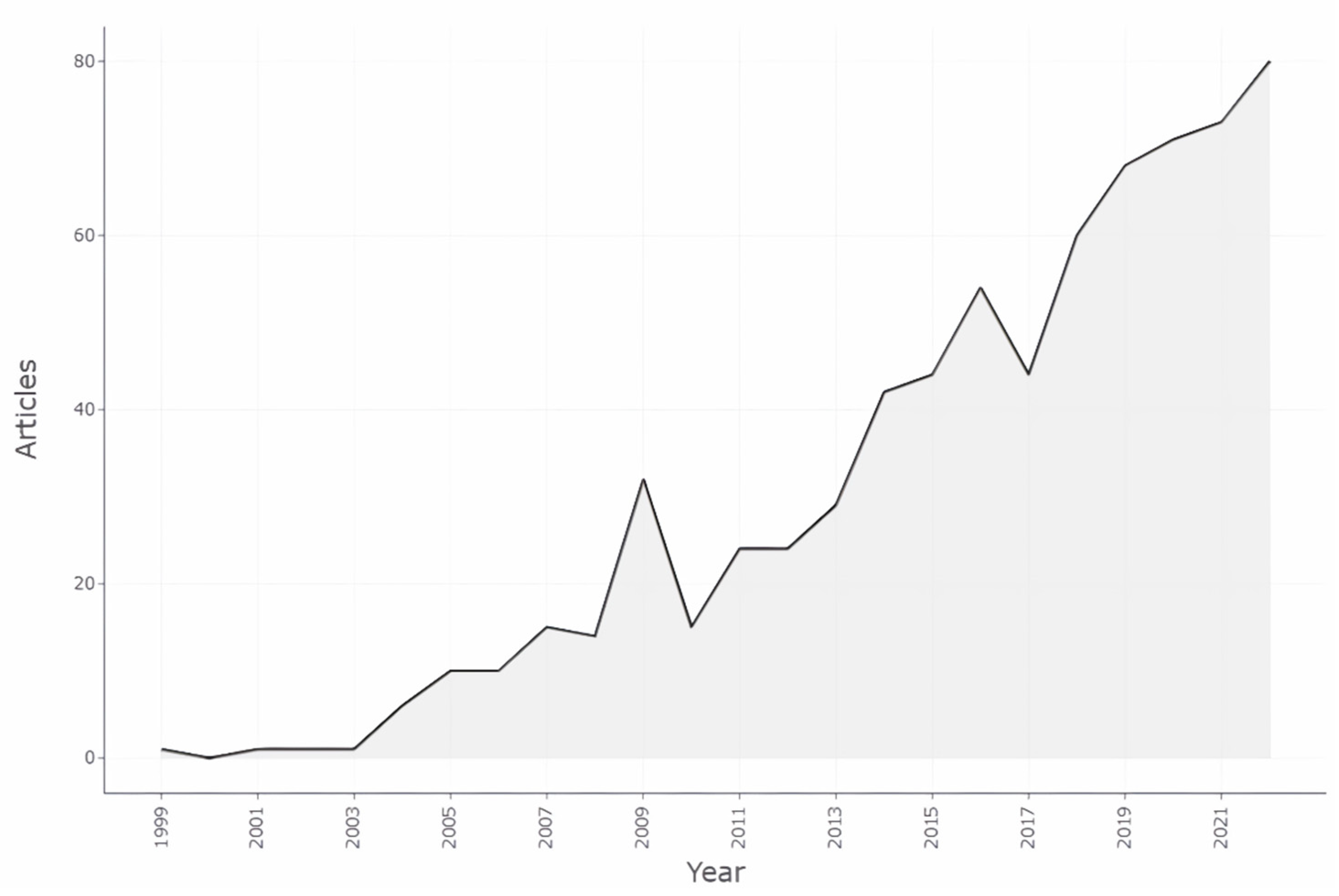
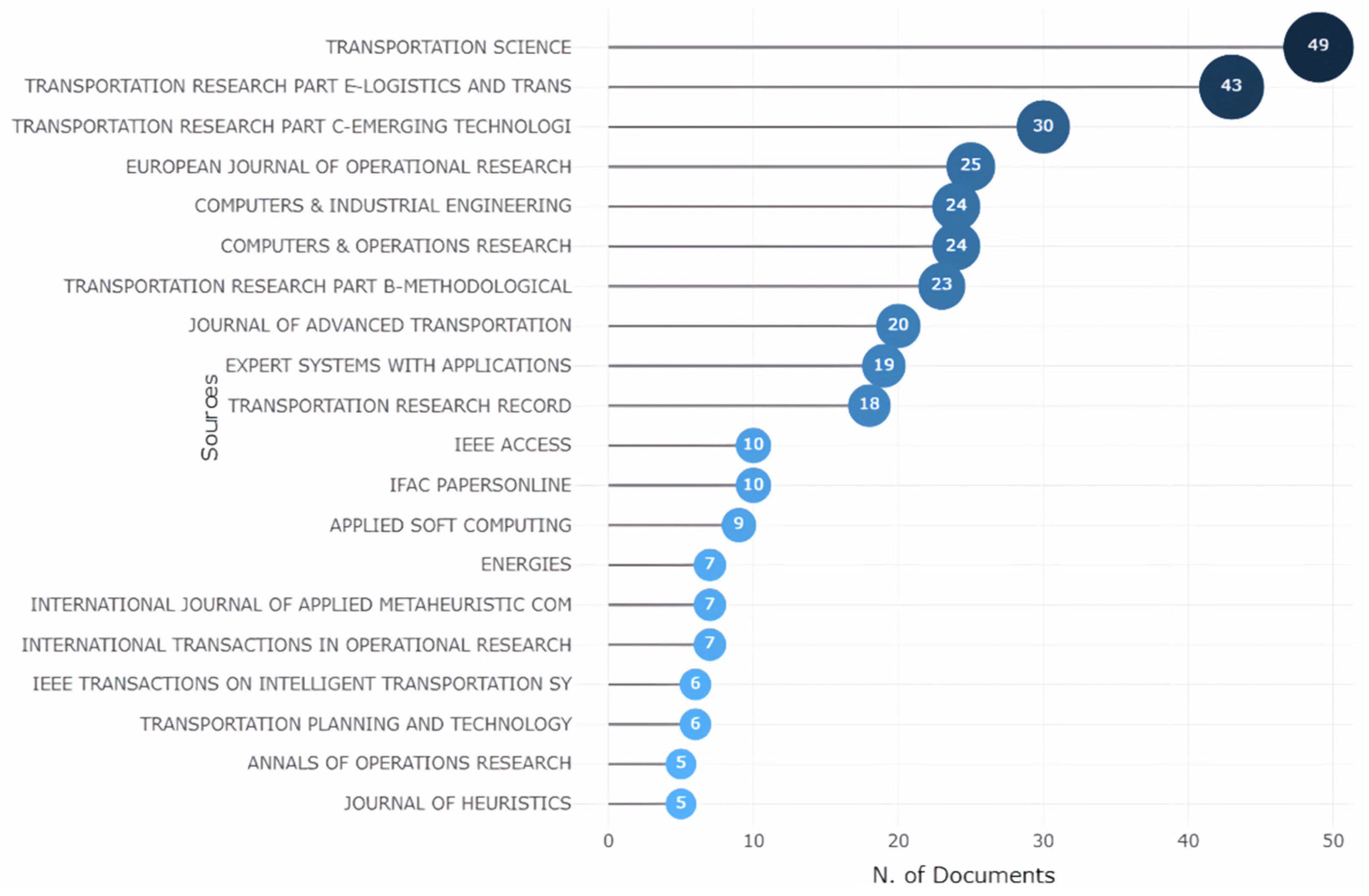
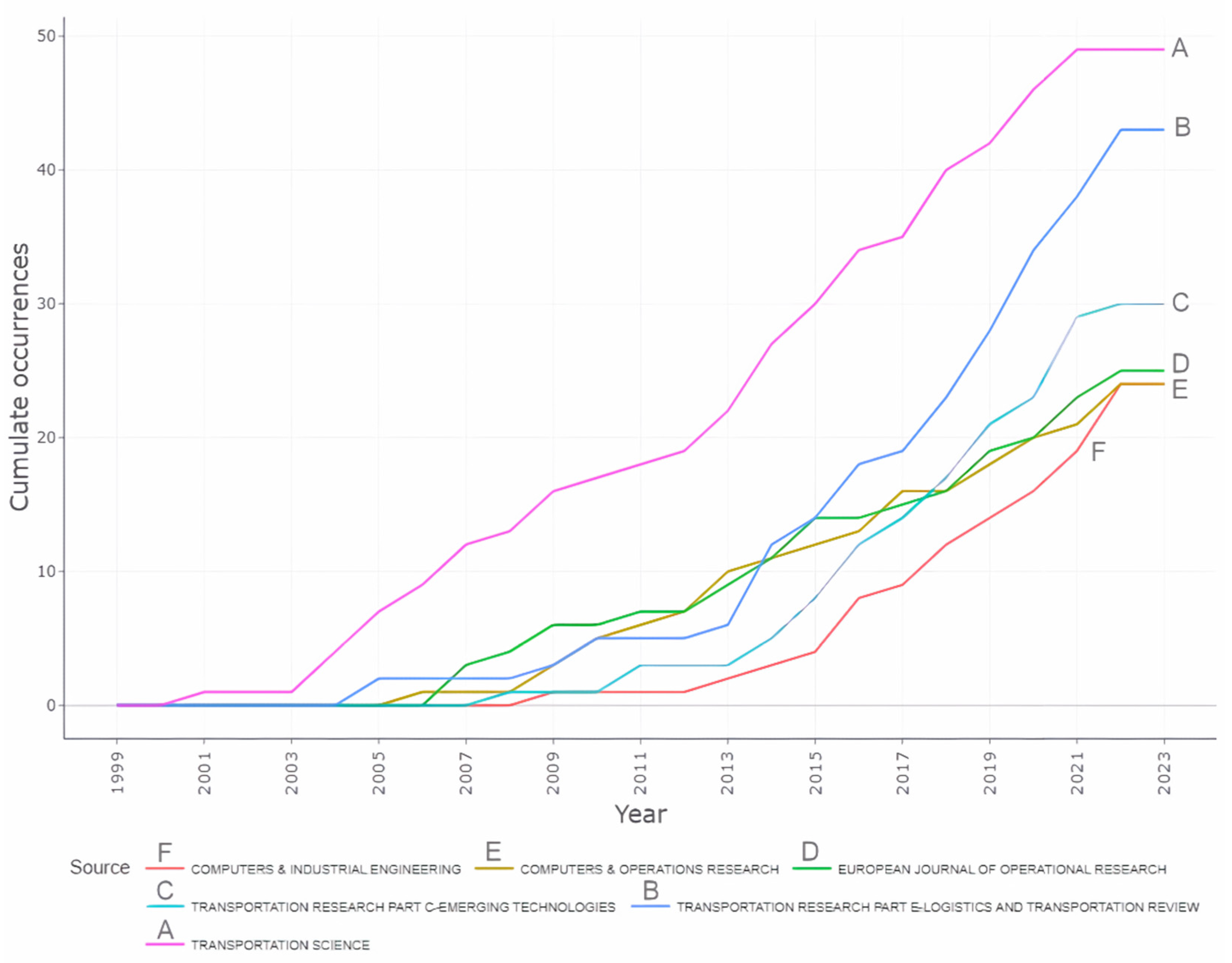
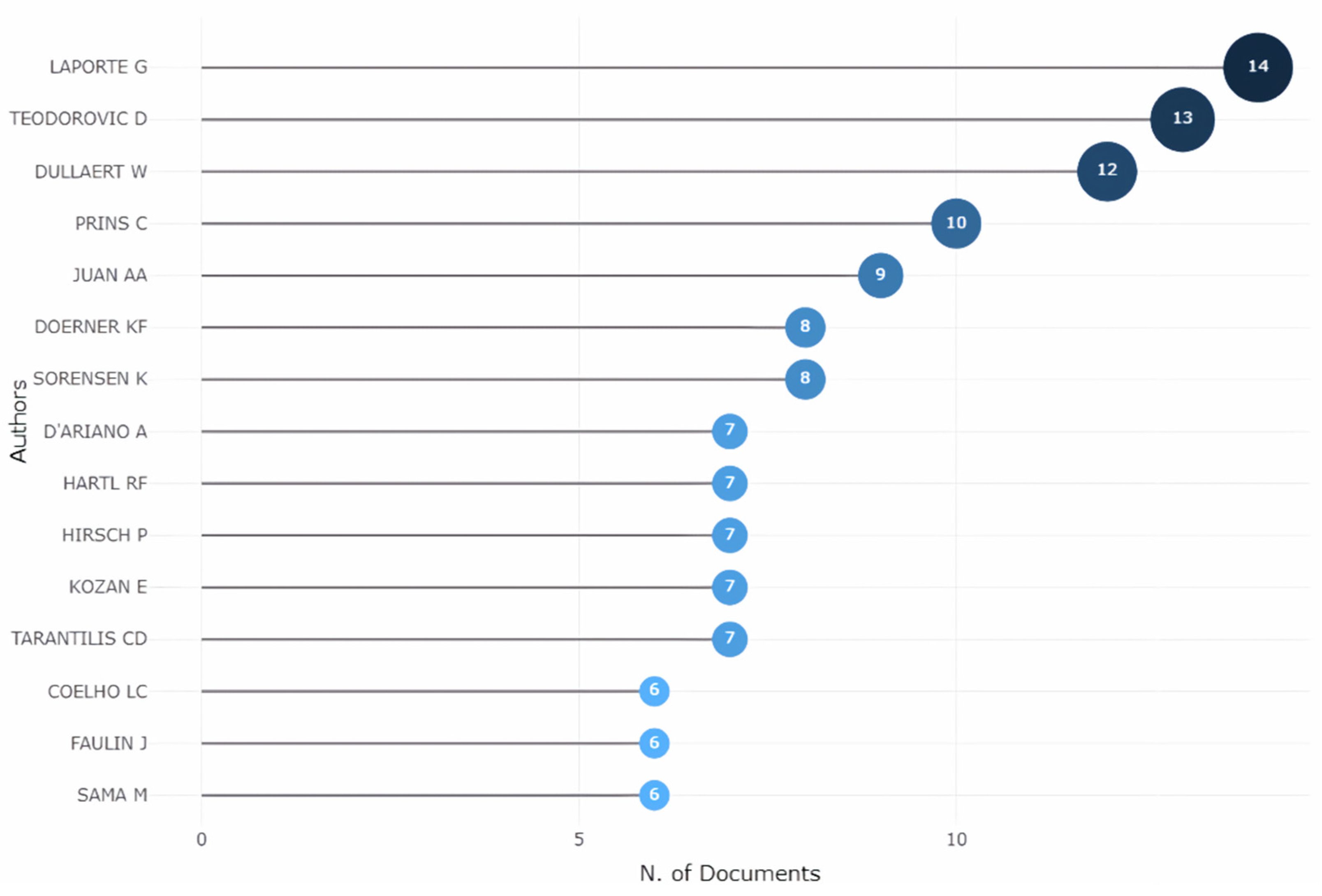
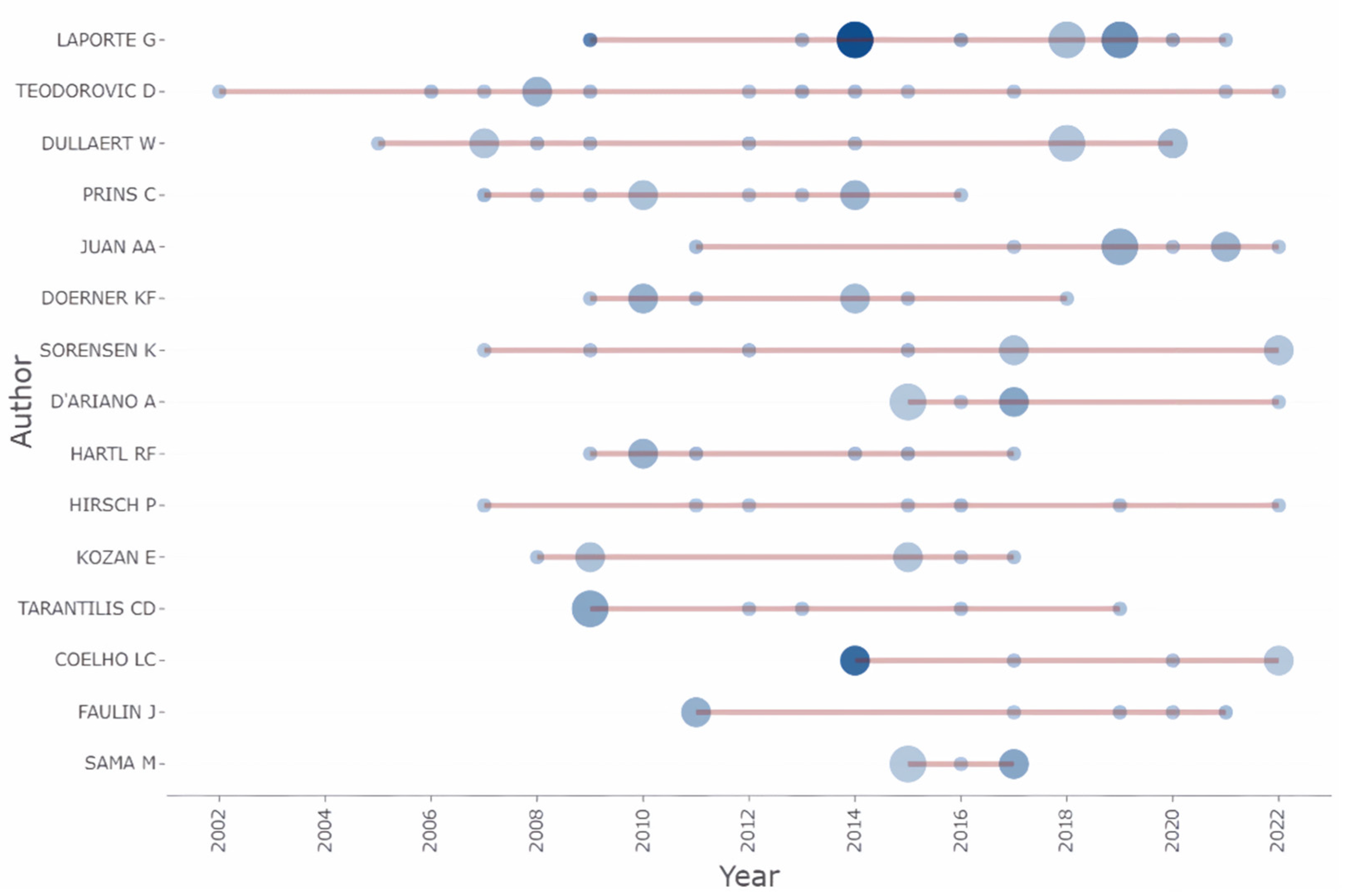
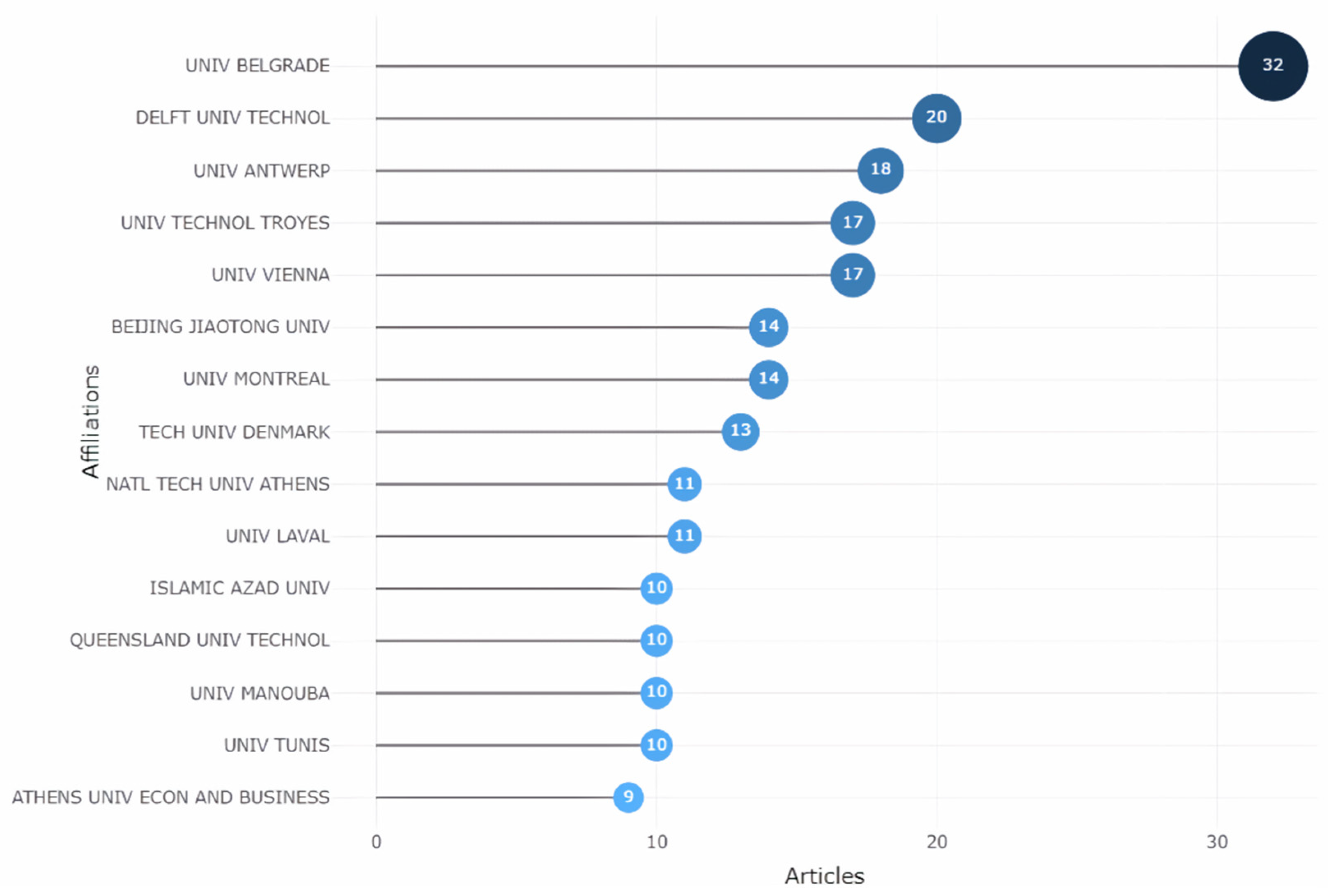
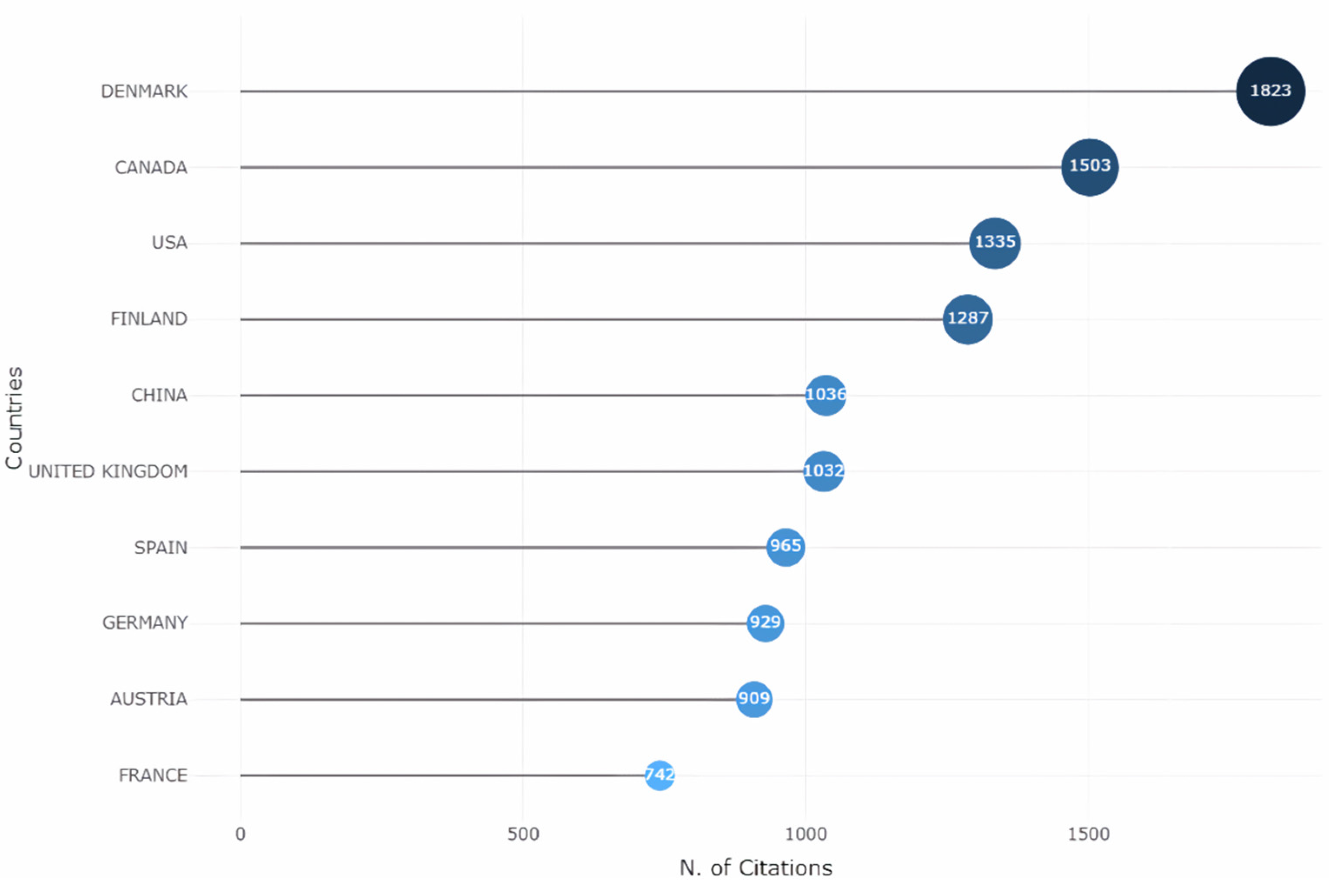
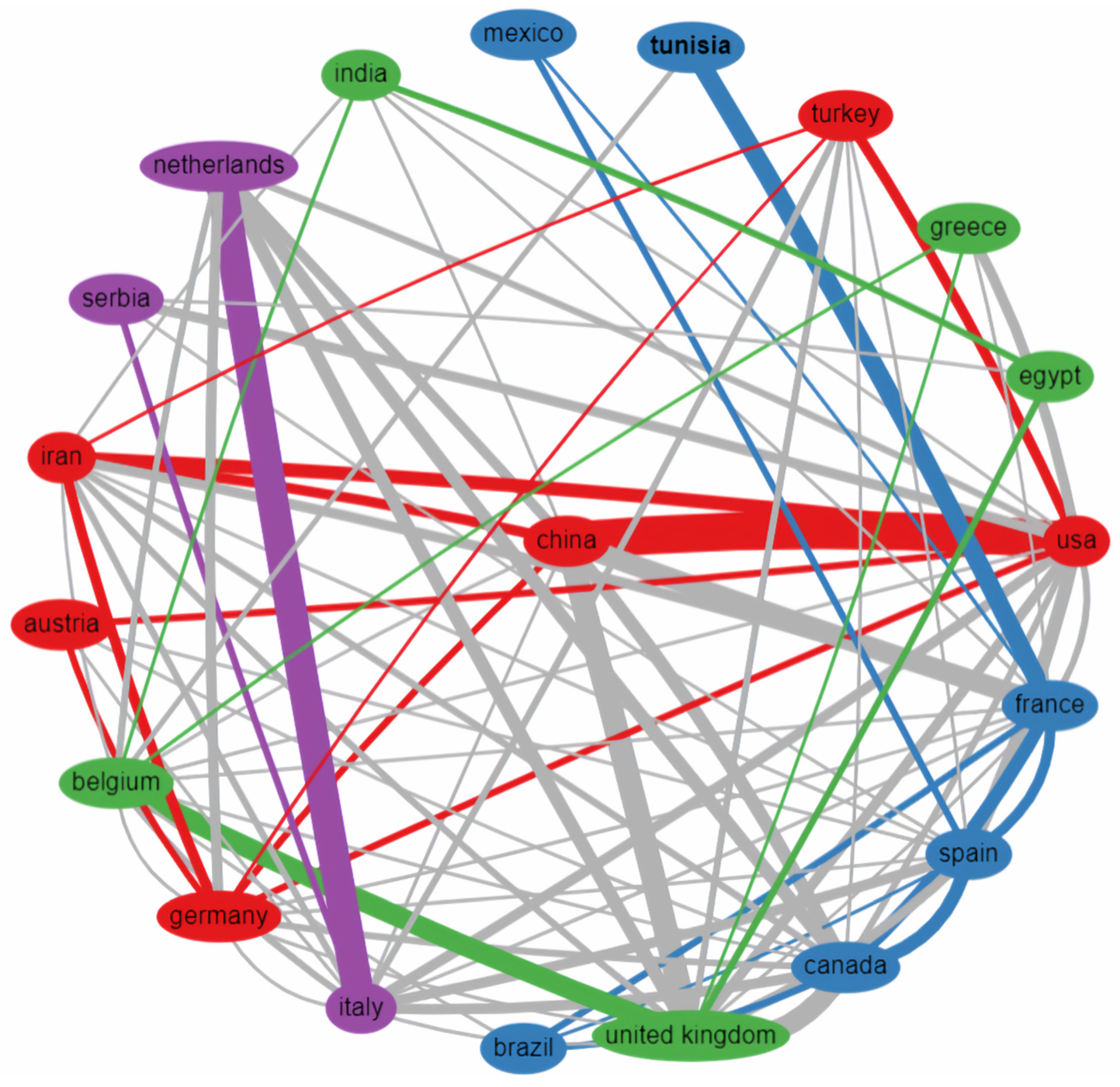
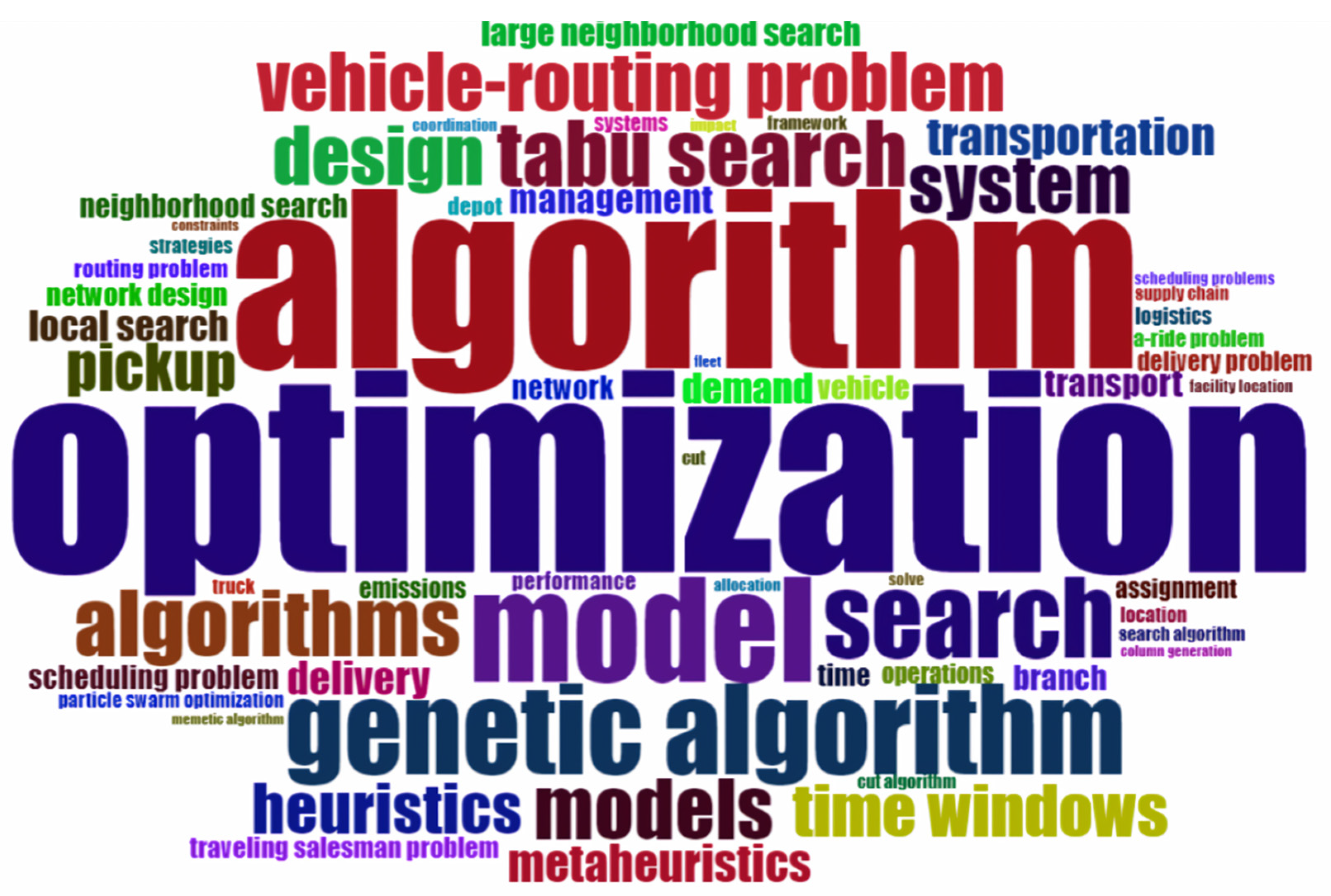
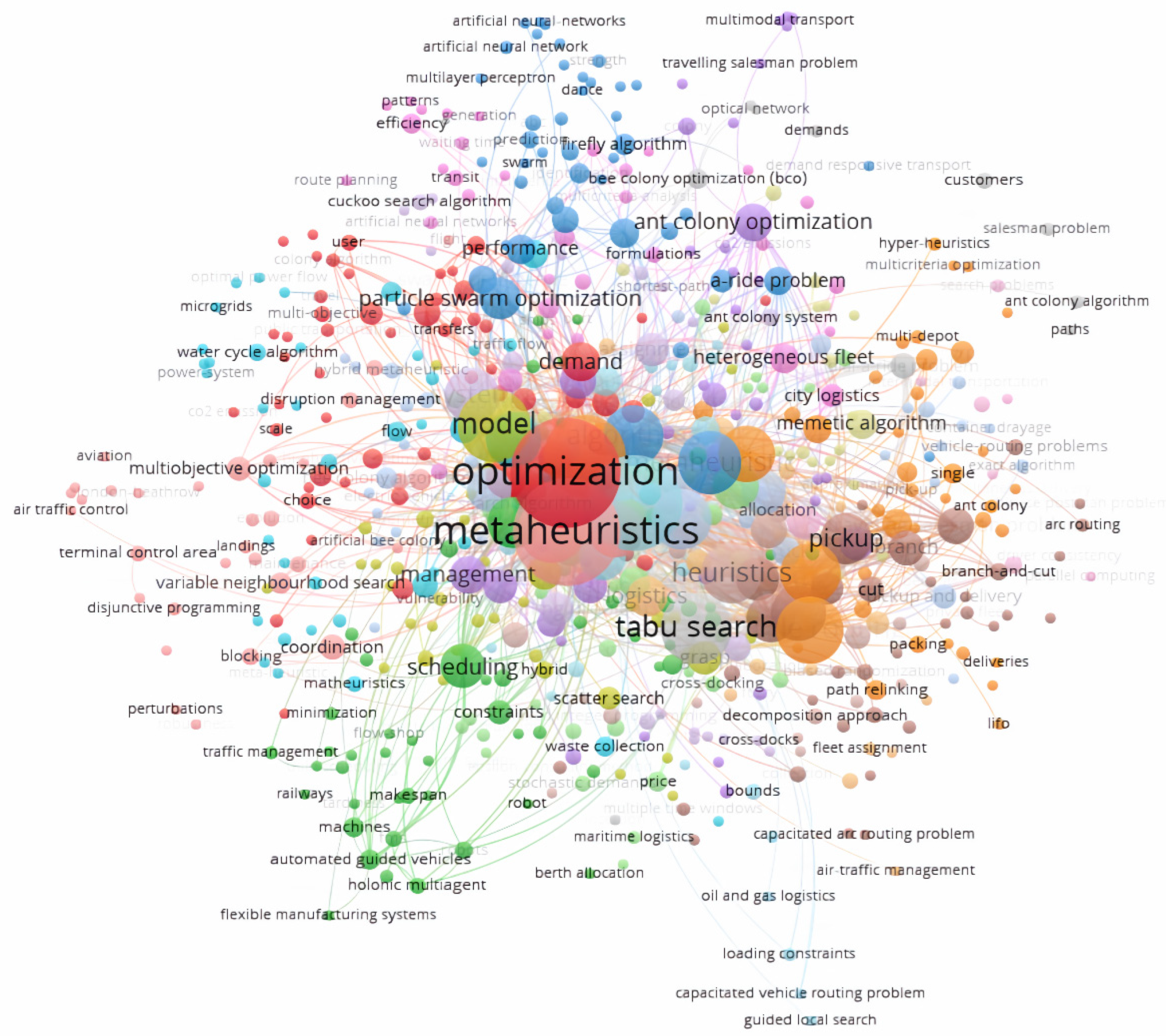
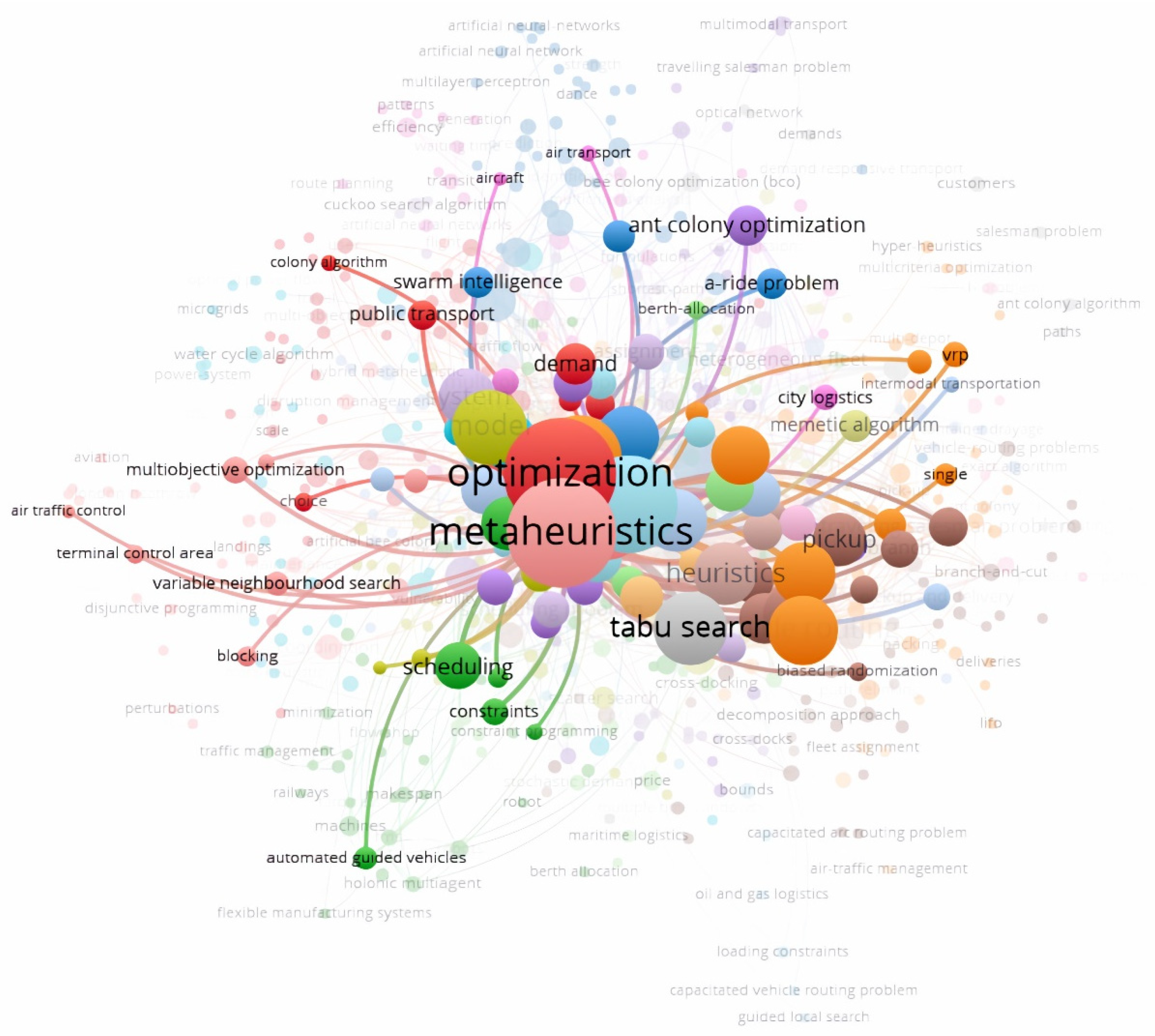

| References | Parent Topics | Categories | Journals |
|---|---|---|---|
| Hasani, A., et al. [20] | Risk of supply chain disruptions | Supply chain | Transportation Research Part E: Logistics and Transportation Review |
| Chen, L., et al. [58] | Transportation for premium customers | Supply chain | Transportation Research Part E: Logistics and Transportation Review |
| Akpinar, M. E. [31] | Long-term profitability | Supply chain | Logforum |
| Patel, M., et al. [62] | Traffic flow prediction with deep convolutional neural networks | Supply chain | Journal of Intelligent Transportation Systems |
| Yanik, S., et al. [63] | Supplier assignment with a hybrid approach | Supply chain | European Journal of Operational Research |
| Baals, J., Emde, S., et al. [50] | Just-in-Time approach to minimize upfront or late costs in supplier networks | Supply chain | European Journal of Operational Research |
| Ghaffarinasab, et al. [64] | Economies of scale | Supply chain | Computers & Operations Research |
| Laporte, G. [65] | Simultaneous pickup and delivery and its impact on customer satisfaction | Efficiency | Naval Research Logistics |
| Shamsaldin, A. S., et al. [66] | Swarm intelligence | Efficiency | Journal of Computational Design and Engineering |
| Posada, M., et al. [48] | Metrics for creating algorithms that improve business efficiency and performance | Efficiency and profitability | International Journal of Urban Sciences |
| Eydi, A., et al. [56] | Models that incorporate value for money over time and supplier profit | Efficiency and profitability | Asia-Pacific Journal of Operational Research |
| Tak, S., et al. [21] | Interconnected and automated vehicles | New transport technologies | Sustainability |
| Somakumar, R., et al. [22] | Emission cost optimization and economic analysis for microgrids | Sustainability | International Journal of Numerical Modelling: Electronic Networks, Devices and Fields |
| Shabbar, R., et al. [67] | Allocation of charging stations for electric vehicle network | Sustainability and efficiency | Sustainability |
| Ntakolia, C., et al. [43] | Optimization of air traffic flow with ant colonies and fuzzy logic | Air transport | Operational Research |
| Hammedi, W., et al. [68] | Optimization of waiting times in locks | Shipping | ACM Transactions on Intelligent Systems and Technology |
| Dozic, S., et al. [57] | Balance between fleet size and demand | Multimodal transport | Transportation Research Procedia |
| Canca, D., et al. [69] | Railways and profit maximization | Ground transportation | Transportation Research Part E: Logistics and Transportation Review |
| Repolho, H. M., et al. [53] | Costs of theft on dangerous routes | Ground transportation | Soft Computing |
| Hu, Q., et al. [70] | Bus tourism problem | Ground transportation | International Transactions in Operational Research |
| Authors | Title | Journal | Institution and Country | Total Citations | Year |
|---|---|---|---|---|---|
| Rokpe, S., et al. [76] | An adaptive large neighborhood search heuristic for the pickup and delivery problem with time windows | Transportation Science | Technical University of Denmark (Denmark) | 1037 | 2006 |
| Braysy, O., et al. [77] | Vehicle routing problem with time windows, Part I: Route construction and local search algorithms | Transportation Science | University of Jyväskylä (Finland) and École Polytechnique de Montréal (Canada) | 624 | 2005 |
| Laporte, G [78] | Fifty years of vehicle routing | Transportation Science | HEC Montréal (Canada) | 504 | 2009 |
| Schneider, M., et al. [79] | The electric vehicle-routing problem with time windows and recharging stations | Transportation Science | RWTH Aachen University (Germany) | 496 | 2014 |
| Braysy, O., et al. [80] | Vehicle routing problem with time windows, Part II: Metaheuristics | Transportation Science | University of Jyväskylä (Finland) and École Polytechnique de Montréal (Canada) | 447 | 2005 |
| Coelho, L.C., et al. [81] | Thirty years of inventory routing | Transportation Science | Université Laval (Canada) and HEC Montréal (Canada) | 318 | 2014 |
| Pisinger, D., et al. [82] | Large neighborhood search | International Series in Operations Research & Management Science | Technical University of Denmark (Denmark) | 304 | 2010 |
| Peng, P., et al. [83] | Reliable logistics networks design with facility disruptions | Transportation Research Part B: Methodological | City University of Hong Kong (People’s Republic of China) | 250 | 2011 |
| Keskin, M., et al. [84] | Partial recharge strategies for the electric vehicle routing problem with time windows | Transportation Research Part C: Emerging Technologies | Sabanci University (Turkey) | 215 | 2016 |
| Montoya, A., et al. [85] | The electric vehicle routing problem with nonlinear charging function | Transportation Research Part B: Methodological | Universidad EAFIT (Colombia) and Université d’Angers (France) | 202 | 2017 |
| Cluster Name | Terms | Details |
|---|---|---|
| Route and transportation basics. Cluster 1 (blue). | Transportation request, ride problem, user, trip, fleet, DARP, road, bus, passenger, demand, planning, timetable | This cluster covers the essential management of transportation routes, focusing on route planning and fleet coordination. It includes the analysis of transportation requests and the demands of both passengers and cargo. With terms like DARP and timetable, it reflects a need for detailed planning and synchronization to optimize resource use across different types of transportation. Additionally, it focuses on transportation demand, aligning services with the specific needs of passengers and users. |
| Metaheuristic and problem solving. Cluster 2 (green). | Metaheuristics, initial solutions, NP-hard problem, near-optimal solutions, scheduling problem, depot, total cost, operator, local search, distance, simulated annealing, vehicle routing problem, customer demand, capacitated vehicle routing, collection. | This group focuses on metaheuristic techniques to solve complex optimization problems, where methods are needed to obtain near-optimal solutions in computationally difficult (NP-hard) problems. Terms like simulated annealing and local search refer to specific approaches for exploring and optimizing routes in vehicle routing problems with constraints, such as capacitated vehicle routing. The solutions in this cluster are aimed at minimizing total costs and meeting specific customer demands through optimization strategies. |
| Operational and cost optimization. Cluster 3 (yellow). | Ant colony optimization, sales problem, loading, truck, variable neighborhood search, destination, operational cost. | In this cluster, the focus is on reducing operational costs within logistics by optimizing loading and distribution processes. The use of techniques such as ant colony optimization and variable neighborhood search highlights specific optimization methods applied in truck routing and sales problems. The terms aim to find efficient routes for trucks and other vehicles that meet delivery destinations while minimizing costs, which has direct applications in resource management and profit maximization in destination logistics. |
| Urban and electric logistics. Cluster 4 (purple). | Station, energy, large neighborhood search, time window, electric vehicle, urban area, delivery problem, task. | This cluster focuses again on logistics but is centered on urban areas and the unique challenges that cities present, such as congestion and time constraints. The inclusion of terms like electric vehicle and energy indicates an interest in sustainable solutions for freight transportation, which is especially relevant in urban environments where electric vehicles are more suitable, given that battery mileage and charging time pose challenges for long-distance optimization. Additionally, the use of time windows and specific tasks highlights the need for precise planning to optimize deliveries within a complex urban context. |
| Supply chain and efficiency models. Cluster 5 (red). | Container, genetic algorithm, value, network, way, cost, performance, efficiency, optimization model, location, decision, impact, optimization problem, routing, logistics, trade, supply chain, combinatorial optimization, risk. | This group encompasses the analysis and optimization of the entire supply chain, from the flow of goods to strategic decision-making. Terms like genetic algorithm and combinatorial optimization indicate an advanced approach in optimization methods to improve efficiency. Additionally, keywords like risk, impact, and location reflect strategic concerns, such as risk mitigation and location decision analysis, to optimize efficiency and reduce costs. This cluster integrates both logistics and global planning within complex supply networks. |
| Authors | Object of Study | Article | Year |
|---|---|---|---|
| Ezugwu, A. E., et al. [98] | Global metaheuristics. Not specialized in the transport sector. | Automatic clustering algorithms: a systematic review and bibliometric analysis of relevant literature. | 2020 |
| Ezugwu, A. E., et al. [99] | Metaheuristics and their taxonomic classification. Not specialized in the transport sector. | Metaheuristics: A comprehensive overview and classification along with bibliometric analysis. | 2021 |
| Baghalzadeh, M., et al. [100] | Metaheuristics and the construction sector. Superficially related to the transport sector. | Internet of things (IoT), building information modeling (BIM), and digital twin (DT) in construction industry: A review, bibliometric, and network analysis. | 2022 |
| Ajibade, S. S. M., et al. [101] | Particle swarm optimization algorithms. Very focused aspect of metaheuristics. | Bibliometric survey on particle swarm optimization algorithms (2001–2021). | 2022 |
| Rabbouch, B., et al. [102] | Related to metaheuristics and transport. Although focused exclusively on transport route problems, it does not cover the subject in its entirety. | Parallel processing algorithms for the vehicle routing problem and its variants: A literature review with a look into the future. | 2020 |
| Deniz, N., et al. [103] | Heuristics and logistics. It extracts information from 40 papers analyzed, so its sample is small and may incur bias problems. | A bibliometric and social network analysis of data-driven heuristic methods for logistics problems. | 2023 |
| Kiani, R., et al. [104] | Metaheuristics and cross docking. | Cross-docking: A systematic literature review. | 2020 |
Disclaimer/Publisher’s Note: The statements, opinions and data contained in all publications are solely those of the individual author(s) and contributor(s) and not of MDPI and/or the editor(s). MDPI and/or the editor(s) disclaim responsibility for any injury to people or property resulting from any ideas, methods, instructions or products referred to in the content. |
© 2024 by the authors. Licensee MDPI, Basel, Switzerland. This article is an open access article distributed under the terms and conditions of the Creative Commons Attribution (CC BY) license (https://creativecommons.org/licenses/by/4.0/).
Share and Cite
Bueno-Ferrer, Á.; De Pablo Valenciano, J.; De Burgos Jiménez, J. Unveiling the Potential of Metaheuristics in Transportation: A Path Towards Efficiency, Optimization, and Intelligent Management. Infrastructures 2025, 10, 4. https://doi.org/10.3390/infrastructures10010004
Bueno-Ferrer Á, De Pablo Valenciano J, De Burgos Jiménez J. Unveiling the Potential of Metaheuristics in Transportation: A Path Towards Efficiency, Optimization, and Intelligent Management. Infrastructures. 2025; 10(1):4. https://doi.org/10.3390/infrastructures10010004
Chicago/Turabian StyleBueno-Ferrer, Álvaro, Jaime De Pablo Valenciano, and Jerónimo De Burgos Jiménez. 2025. "Unveiling the Potential of Metaheuristics in Transportation: A Path Towards Efficiency, Optimization, and Intelligent Management" Infrastructures 10, no. 1: 4. https://doi.org/10.3390/infrastructures10010004
APA StyleBueno-Ferrer, Á., De Pablo Valenciano, J., & De Burgos Jiménez, J. (2025). Unveiling the Potential of Metaheuristics in Transportation: A Path Towards Efficiency, Optimization, and Intelligent Management. Infrastructures, 10(1), 4. https://doi.org/10.3390/infrastructures10010004







